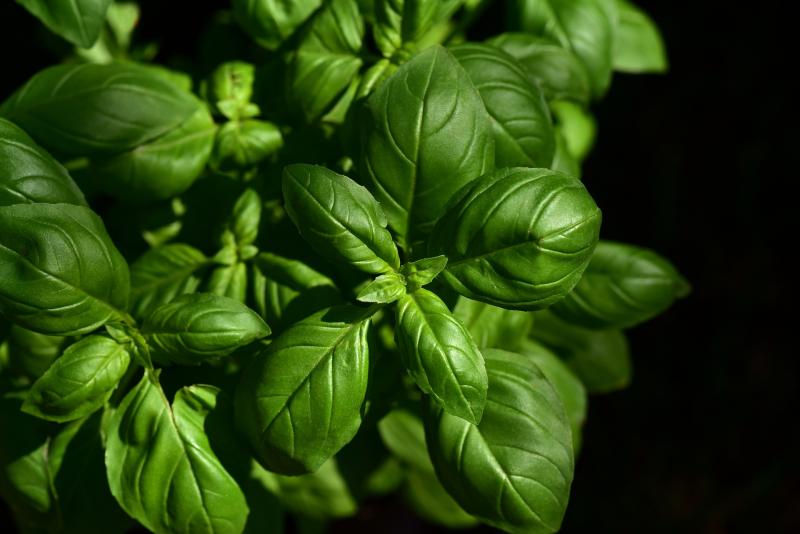Sarah Browning, Nebraska Extension Educator

The herb basil - image by Pixabay.com
Do you have beautiful herbs in your garden and want to preserve them for use this winter? August and September are the time to get started drying your herbs.
Harvest herb stems for drying from stems that are in the bud stage, but have not yet flowered. This is the stage at which leaves contain the highest amount of aromatic, essential oils. If your plants are blooming, cut the blooming stems back about six inches, then let new growth develop. Harvest the new growth when it is at least six inches long. Remove any dead or damaged leaves.
If the leaves and stems are not clean, brush off any loose dirt with a soft pastry brush. Washing is necessary only if the herbs are very gritty, but be sure to pat off any excess water with a paper towel before beginning the drying process.
Stop harvesting stems from perennial herbs, like thyme and sage, by mid-September. This allows them to continue growing and store enough energy for overwintering.

Tips for Drying Herbs in Bunches
To be successful with drying herbs, it’s important to remove the water from the leaves, but at the same time keep as much aromatic oil and other compounds as possible. It’s not difficult to preserve herbs, but it must be done with care.
If your plants are clean and free of pesticides, immediately after picking hang small, loose bunches upside down from a rack (or suspended from a line or cord). Don’t make the bunches too large. There is a risk the leaves won’t dry properly and mold may develop on the leaves if enough air can’t circulate through the bunch.
The ideal place to dry herbs is a warm, dark, and well-ventilated place. Ideally the temperature should be about 90°F. Avoid hanging herbs in the kitchen, even though it looks very attractive. Kitchens are often full of condensation from cooking. It is also not advisable to dry herbs in the oven, because no matter how low the temperature is the flavor degrades more than with other methods.
To prevent dust from settling on the bunches, place a paper bag over the herbs, leaving the bottom open to the air.

Other Herb Drying Methods
Additional ways to dry herbs include laying them flat on screens, using a food dehydrator or using your microwave.
If leaves are not too small, they may be removed from the stems and dried in a single layer on trays made of window screening or ¼ inch mesh hardware cloth.
To dry herbs in your food dehydrator, place stems in a single layer on the trays. Preheat the dehydrator to between 95-115°F. Check the herbs periodically. Drying times varies from one to four hours.
Using your microwave oven is another quick way to dry herbs, but must be done carefully to avoid scorching them.
- Place small bunches of herbs between two paper towels.
- After about 1 minute, turn the herbs and continue microwaving at 20-30 second intervals. Timing depends on the thickness of the plant part being dried and the strength of your microwave oven. Never leave the microwave unattended because herbs can scorch and start burning if they’re in the oven too long.
- Test for the correct level of dryness by crushing a few leaves or stems. They should be dry and brittle, crumbling into leaf bits or powder when rubbed between your hands. If they become too dry, you’ll have powdered herbs.
When the drying process is complete, remove the leaves from their stems and place them in sealed grass jars and store them in a warm place. Label each container with the herb name and date harvested. Examine the jars daily to determine if any moisture has condensed on the inside of the glass. If it has, remove the contents and spread them out for further drying. If necessary, the final drying may be completed by spreading the leaves on a cookie sheet in an oven set for 110°F or less.
Flavor will be best if the herb leaves are stored whole and crushed just before adding them to food. To use herbs in a powdered or ground form, crush the leaves with a rolling pin, pass them through a fine sieve, grind them in a blender or food processor, or with a mortar and pestle. Store dried herbs out of direct sunlight to prevent their color from fading.
Images from Pixabay.com
- Lavender, rosemary and thyme sprigs ready for drying.
- Mint, parsley, and thyme herbs.
Search Our Archive
Associated Video
Green and Growing Tip: Basil
Nebraska Extension Horticulture Assistant Terri James talks about preserving basil